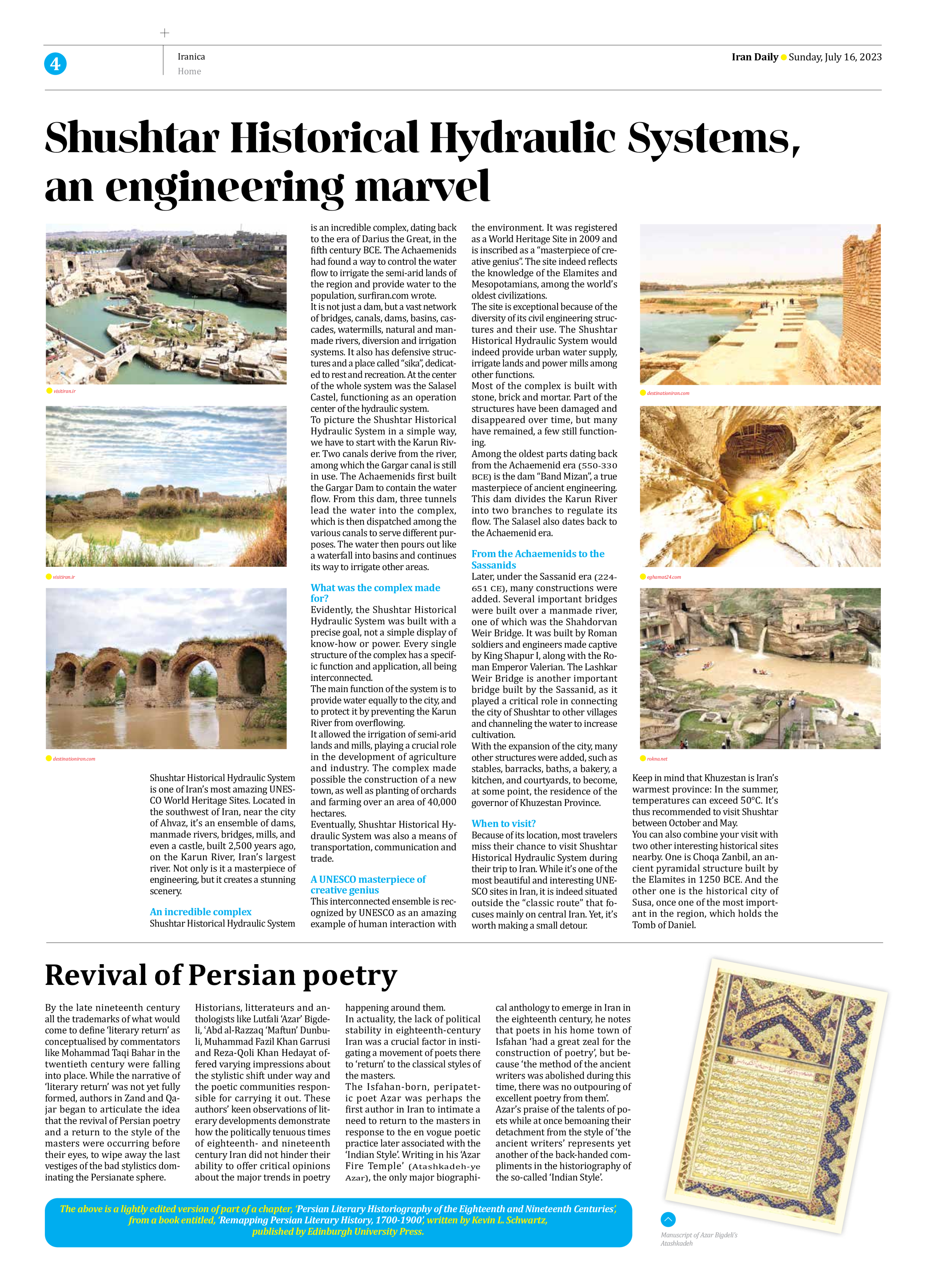
Shushtar Historical Hydraulic Systems, an engineering marvel
Shushtar Historical Hydraulic System is one of Iran’s most amazing UNESCO World Heritage Sites. Located in the southwest of Iran, near the city of Ahvaz, it’s an ensemble of dams, manmade rivers, bridges, mills, and even a castle, built 2,500 years ago, on the Karun River, Iran’s largest river. Not only is it a masterpiece of engineering, but it creates a stunning scenery.
An incredible complex
Shushtar Historical Hydraulic System is an incredible complex, dating back to the era of Darius the Great, in the fifth century BCE. The Achaemenids had found a way to control the water flow to irrigate the semi-arid lands of the region and provide water to the population, surfiran.com wrote.
It is not just a dam, but a vast network of bridges, canals, dams, basins, cascades, watermills, natural and manmade rivers, diversion and irrigation systems. It also has defensive structures and a place called “sika”, dedicated to rest and recreation. At the center of the whole system was the Salasel Castel, functioning as an operation center of the hydraulic system.
To picture the Shushtar Historical Hydraulic System in a simple way, we have to start with the Karun River. Two canals derive from the river, among which the Gargar canal is still in use. The Achaemenids first built the Gargar Dam to contain the water flow. From this dam, three tunnels lead the water into the complex, which is then dispatched among the various canals to serve different purposes. The water then pours out like a waterfall into basins and continues its way to irrigate other areas.
What was the complex made for?
Evidently, the Shushtar Historical Hydraulic System was built with a precise goal, not a simple display of know-how or power. Every single structure of the complex has a specific function and application, all being interconnected.
The main function of the system is to provide water equally to the city, and to protect it by preventing the Karun River from overflowing.
It allowed the irrigation of semi-arid lands and mills, playing a crucial role in the development of agriculture and industry. The complex made possible the construction of a new town, as well as planting of orchards and farming over an area of 40,000 hectares.
Eventually, Shushtar Historical Hydraulic System was also a means of transportation, communication and trade.
A UNESCO masterpiece of creative genius
This interconnected ensemble is recognized by UNESCO as an amazing example of human interaction with the environment. It was registered as a World Heritage Site in 2009 and is inscribed as a “masterpiece of creative genius”. The site indeed reflects the knowledge of the Elamites and Mesopotamians, among the world’s oldest civilizations.
The site is exceptional because of the diversity of its civil engineering structures and their use. The Shushtar Historical Hydraulic System would indeed provide urban water supply, irrigate lands and power mills among other functions.
Most of the complex is built with stone, brick and mortar. Part of the structures have been damaged and disappeared over time, but many have remained, a few still functioning.
Among the oldest parts dating back from the Achaemenid era (550-330 BCE) is the dam “Band Mizan”, a true masterpiece of ancient engineering. This dam divides the Karun River into two branches to regulate its flow. The Salasel also dates back to the Achaemenid era.
From the Achaemenids to the Sassanids
Later, under the Sassanid era (224-651 CE), many constructions were added. Several important bridges were built over a manmade river, one of which was the Shahdorvan Weir Bridge. It was built by Roman soldiers and engineers made captive by King Shapur I, along with the Roman Emperor Valerian. The Lashkar Weir Bridge is another important bridge built by the Sassanid, as it played a critical role in connecting the city of Shushtar to other villages and channeling the water to increase cultivation.
With the expansion of the city, many other structures were added, such as stables, barracks, baths, a bakery, a kitchen, and courtyards, to become, at some point, the residence of the governor of Khuzestan Province.
When to visit?
Because of its location, most travelers miss their chance to visit Shushtar Historical Hydraulic System during their trip to Iran. While it’s one of the most beautiful and interesting UNESCO sites in Iran, it is indeed situated outside the “classic route” that focuses mainly on central Iran. Yet, it’s worth making a small detour.
Keep in mind that Khuzestan is Iran’s warmest province: In the summer, temperatures can exceed 50°C. It’s thus recommended to visit Shushtar between October and May.
You can also combine your visit with two other interesting historical sites nearby. One is Choqa Zanbil, an ancient pyramidal structure built by the Elamites in 1250 BCE. And the other one is the historical city of Susa, once one of the most important in the region, which holds the Tomb of Daniel.







